Acoustic Comfort in Learning Spaces: Moving Towards Sustainable Development Goals
Abstract
1. Introduction
2. Materials and Methods
- SCIENTIFIC LITERATURE. There is a broad consensus in the international community regarding the advances that the design of spaces implies for educational improvement, as seen in the scientific literature consulted. National and international scientific studies included in referenced journals have been reviewed, as well as referenced conference proceedings. Books published since 2010 about learning spaces and reports available online were consulted. The keywords used for the search were: Acoustic comfort, noise in schools, sustainable development goals, learning spaces, school design, and participatory approaches. Science direct and Google Scholar engines were used to find articles. Once the articles were selected, references were looked over to identify other relevant studies. In this second search, we preferred papers, which had been made available through open access publications.
- PLANS & LEGISLATION. Regulations for the construction of public secondary schools in the Valencian Community have been consulted, as well as the floor plans of twenty high schools. The report, which was sent to the Inspection of Education [12] after the inauguration of IES Mediterrània of Benidorm (Alicante) in 2007, can be considered as the initial concern for this investigation.
- DESIGN THINKING WORKSHOPS. We are aware of the importance of participatory approaches in an education for sustainable development education. Therefore, we have promoted and attended design thinking processes for the planning of university learning spaces. Outcomes of these workshops [13] are easily comparable with high school requirements and therefore have been used in point four of this paper to contribute to solutions and suggestions.
- PROJECT WORK FOR AWARENESS. Students were involved in projects implementing a methodology of participatory action research in order to raise awareness of noise issues and highlight that we all need to be part of the solution. An example of these activities is the video mentioned in Section 3.2 “Architects, Help!” [14].
- SURVEYS, INTERVIEWS AND FIELDWORK. We have visited thirty schools in the Valencian Community, mainly in the province of Alicante and conducted individual and collective interviews to principals and teachers. Furthermore, a structured survey, about the efficiency of learning spaces was sent to teachers of the high schools in the province of Alicante. The Educational Authorities of Alicante (Dirección Territorial de Educación de Alicante) have been informed of the ongoing investigation. Gathering of statistical data and indicators supplied by surveys, interviews and visits to IES occurred between July 2018 and March 2019, although other informal school tours and interviews had been taking place for an extended period of time.
- ○
- Interviews. A total number of twenty-two directors were interviewed using a face-to-face semi structured interview [15], that is, previously prepared questions, but that can be adjusted or new ones added according to the participants’ answers. One hundred percent of the public high schools in the city of Elche (Alicante), fifteen in total, participated in the study. The duration of each interview and the school tour that followed lasted between one and a half to two hours.
- ○
- Survey. The day after the interview, an online structured questionnaire, specific for teachers, was sent for the principal of the high school to pass on to the staff. This tool provided the investigation with feedback from teachers concerning conditions of the spaces they use as well as the methodologies they implement. It also gives specific information concerning the subject each teacher lectures teaches with a differentiation between academic subjects, taught in standard classrooms and practical ones, which use specific classrooms or workshops. For this particular paper, only the answers concerning acoustics in standard classrooms were considered, 147 responses in total. The findings are summarized later in this article. See Figure 3 for distribution of subjects.
3. Findings and Discussion
3.1. Findings Obtained from Scientific Review
3.1.1. Negative Effects of Noise in Schools
3.1.2. Practical Compared to Academic Subjects
3.1.3. A Participatory Approach
3.2. Findings Obtained from Plans and Legislation
3.3. Findings Obtained from Field Work, Interviews and Survey
3.3.1. Findings from the Teachers’ Questionnaire
- Are the acoustic conditions of the classrooms in which you teach acceptable (There is no reverberation or echo)?
- p096. Are noises from outside or adjacent spaces minimum (they do not cause disruption/discomfort)?
- p-value = 4.353 × 10−6 concerning acoustic conditions inside the rooms (tiling, shape, structure)
- p-value < 2.2 × 10−16 regarding insulation from outside noise or adjacent rooms.
- How important do you consider a better conditioning of learning spaces in order to perform in optimal conditions. Teachers were asked to answer on a scale from one to five. Although this inquiry does not directly refer to acoustics it has a direct relation to it. The results were categorized in two levels: Those who value the need of better conditioning positively (rate 4 and 5 measured on the Likert scale) or negatively (rate 1, 2, and 3).
- How would teachers use active methodologies in optimal working conditions in relation with the methods they are using currently? Each rating (actual and optimal use) was collected on a scale from 0 to 10, therefore the difference is on a scale between (−10,10). Positive rates identify a proactive attitude towards the incorporation of active methodologies providing optimal conditions were given in the school.
3.3.2. Music Rooms
3.3.3. Foreign Languages
4. Recommendations and Conclusions
4.1. Recommendations
4.1.1. Category I. High Financial Cost
- Heating and ventilation ducts are noise conductors. Shared systems should be avoided in order to prevent noise interference [51].
- The geometry of space also influences acoustic comfort. In rooms that are narrow, sound bounces back from the walls generating reverberation and acoustic discomfort to the users [37], therefore square spaces are more acoustically comfortable.
- Vertical ceramic tiling or huge glass windows increase reverberation. The echoing of sound is worse when walls, floors and ceilings are not porous. It has been observed, in certain schools, that they have added porous elements, for example, sound-absorbing ceiling or covering vertical paneling with cork, and this has improved greatly the sound quality in the room.
- Classroom doors should not face each other [25].
- It is strongly recommended that a guide be written specifically for high schools, with instructions on where to position the noisiest spaces, bearing in mind that in IES in Spain, adult education and young students share the same premises and once the building is occupied structural changes are difficult and expensive.
4.1.2. Category II. Medium Cost
- Insulate rooms with double glazed windows.
- Light sources and air conditioning units for libraries, reading and study rooms should be especially silent [20].
- Music rooms should keep windows closed at all times when playing instruments. In the SE of Spain air conditioning would be required in such cases. This choice does not contradict the previous point, as activities conducted in these premises are usually louder than the level of noise produced by air conditioning units.
- An idea noticed at IES Tirant lo Blanc, Elche, was to equip certain instruments in the music room with headsets for individual rehearsals.
- In high schools, designing at least one Foreign Language lab would be sensible, properly insulated and equipped with quality loudspeakers for reproducing listenings, video conferences and videos of native speakers. This solution is just a matter of interior design of a standard classroom.
- For the purpose of avoiding the noise that is generated from moving desks and chairs every 55 minutes, it is advisable to install felt or rubber studs under chair and desk legs [7,26] or arrange timetables of certain classrooms for longer periods of active methodologies. This is the measure that has been adopted at IES Cayetano Sempere in Elche, where teachers that more often use project work are assigned to certain rooms.
- In the same line as mentioned above, a specific area for project work, co-working, thinking-lab, as seen in Figure 8, could be adapted for the use of general academic subjects, which are usually taught in standard classrooms. Again, this is a matter of interior design not structural changes.
4.1.3. Category III. Low Cost
- It is recommended to replace the siren or bell indicating the end of the lesson by music [26]. In 12 of the 30 schools evaluated this measure has been implemented, in some cases involving students and making them responsible for the type of music chosen for the occasion. Loudspeaker systems should be tested and function correctly for a better operation of this solution.
- Studies verify that working in offices with tables in “open-planning” increase distraction. In these areas they suggest the use of plants as barriers, soft music or nature sounds in order to improve concentration [17]. Very few of the schools evaluated have silent rooms for teachers to correct papers, prepare lessons or do research. Most teachers express that they work at home or in the main teachers’ room under conditions that are not favorable for concentration.
- Open spaces also have advantages but it is necessary to create privacy for certain activities, such as personalized tutoring or private parent meetings. One hundred percent of the principals interviewed claimed lack of space, and therefore declare to optimize corners in corridors or other areas and make them suitable. Some companies design special furniture for these purposes, as the example in Figure 9.
4.2. Conclusions
- In the past, building design in learning spaces was not as influential as it is nowadays, at least concerning acoustic needs, since the classes were more teacher-centered and consequently more silent.
- Nowadays, findings prove that classrooms do not meet the appropriate noise requirements to be able to complete cognitive assignments, which require concentration [55]. With regard to the question concerning physical space, are the classrooms acoustically conditioned (even for traditional methodologies)? Results of the surveys and interviews show that the conditions need to be improved. We suggest that planners, architects and engineers participate more closely with the school community in order to empathize and understand more about methodologies that are being implemented. Specific mention is the case of the planning of the music rooms or sport fields seen in Figure 6 and Figure 7.
- About the questions regarding methodologies, can acoustic discomfort limit or slow down teachers’ urge to implement innovative strategies? Are classrooms acoustically conditioned for implementing new methodologies? Findings from the interviews state that if, for example, moving furniture causes a noise that may bother colleagues or if there is reverberation, echo or disruption from outside, the teacher tends to implement activities that are more silent and easier to control. This case was mentioned specially by foreign language teachers.
- Concerning the question about health issues, does the need to battle background noise cause throat problems, temporary voice loss, and other physical, emotional or mental problems? There is no doubt to this question, whose response can be found in numerous articles worldwide, many of which have been cited in this paper. The investigation reveals that noise pollution and reverberation is a major discomfort for teachers and students. It produces irritability, lack of concentration, weariness, depression, headaches and so on. In students it may cause a drop in academic results, especially in mathematics or languages. In teachers, it can mean taking sick leave due to voice ailments. Therefore, findings of the research should have practical consequences for the design and/or refurbishment of schools [7,22,24].
- In the following explanation we find the response to the key question can acoustic comfort facilitate innovation and consequently help in the progress towards SDG? During our observation we have seen that progress towards an education for sustainable development is being achieved by implementing more participatory, active and student-based pedagogies. Many of these pedagogies tend to raise the noise level of classrooms. If we improve acoustic conditions, activities taking place in one room will not interfere or be a bother for users of adjacent rooms that may be writing exams or implementing tasks that require less noise tolerance. Teachers will feel free to choose their activities and teaching method as needed and not limited by the acoustic conditions of space. We believe this will help progress towards SDG and allow students to thrive in different learning environments.
- We are aware that improving the academic results and motivation of students and teachers and implementing new methodologies is a complex and challenging task that should not be simplified to an issue of space design. However, structural features of the classroom in particular and the school building in general are undoubtedly decisive.
- The most successful way to reach creative solutions is through a participatory approach that involves the whole school community as well as designers and planners. Viable solutions are possible for all different types of budgets, as has been indicated in point 4.1.
- Finally, we consider it is essential to prepare a White Paper for the design of public high schools in Spain for the sake of moving towards sustainable development goals.
Author Contributions
Funding
Conflicts of Interest
References and Notes
- Benayas, J.; Marcén, C.; Alba, D.; Gutiérrez, J. Educación Para la Sostenibilidad en España. Reflexiones y Propuestas. Fundación Alternativas y Red Española Para el Desarrollo Sostenible; Documento de Trabajo Opex No. 86/2017; Fundación Alternativas: Madrid, Spain, 2017. [Google Scholar]
- Bascopé, M.; Perasso, P.; Reiss, K. Systematic Review of Education for Sustainable Development at an Early Stage: Cornerstones and Pedagogical Approaches for Teacher Professional Development. Sustainability 2019, 11, 719. [Google Scholar] [CrossRef]
- Breiting, S.; Mayer, M.; Mogensen, F. Criterios de Calidad para Escuelas de EDS. Austrian Federal Ministry of Education, Science and Culture, Dept. V/11c 2005. Available online: https://www.ensi.org/global/downloads/Publications/211/QC-ESP.pdf (accessed on 3 February 2019).
- Crampton, F.E. Spending on school infrastructure: Does money matter? J. Educ. Adm. 2009, 47, 305–322. [Google Scholar] [CrossRef]
- Woolner, P.; Hall, E. Noise in Schools: A Holistic Approach to the Issue. Int. J. Environ. Res. Public Health. 2010, 7, 3255–3269. [Google Scholar] [CrossRef] [PubMed]
- Woolner, P.; Thomas, U.; Tiplady, L. Structural change from physical foundations: The role of the environment in enacting school change. J. Educ. Chang. 2018, 19, 223–242. [Google Scholar] [CrossRef]
- Gilavand, A.; Jamshidnezhad, A. The Effect of Noise in Educational Institutions on Learning and Academic Achievement of Elementary Students in Ahvaz, South-West of Iran. Int. J. Pediatrics Mashhad 2016, 4, 1453–1463. [Google Scholar]
- Guardino, C.A.; Fullerton, E. Changing Behaviors by Changing the Classroom Environment. Teach. Except. Child. 2016, 42, 8–13. [Google Scholar] [CrossRef]
- Rantala, L.; Sala, E. Associations between Classroom Conditions and Teacher’s Voice Production. Energy Procedia 2015, 78, 3120–3125. [Google Scholar] [CrossRef]
- Guía de Diseño de Espacios Educativos. Proyecto conjunto del Ministerio de Educación con Unesco-Orealc. In Reforma Educativa Chilena: Optimización de la Inversión en Infraestructura Educativa; MINEDUC; UNESCO: Santiago, Chile, 1999. [Google Scholar]
- Campell, C.; Brokmann, H.; Vugts, J.; Van Oorschot, E. Acoustic Impact on Effective Teaching and Learning Activities in Open Learning Spaces. In Proceedings of the Conference Proceedings Euronoise, Crete, Greece, 27–31 May 2018; pp. 1741–1748. Available online: http://www.euronoise2018.eu/docs/papers/293_Euronoise2018.pdf (accessed on 21 March 2019).
- Informe Anexo Memoria Dirección Fin De Curso IES Mediterrània 2006/07. Available online: http://bit.ly/2YckjN3 (accessed on 21 March 2019).
- Montiel, I.; Mayoral, A.M. Promoting Innovative Learning Spaces at Universidad Miguel Hernández. In ICERI 2018 Proceedings; IATED: València, Spain, 2018; pp. 4790–4797. [Google Scholar]
- Video Produced by 2° ESO Students in 2018 at IES Mediterrània, Benidorm, Spain. “Arquitects Help!”. Available online: http://bit.ly/2Ycx6PA (accessed on 21 March 2019).
- Ramli, N.H.; Ahmad, S.; Taib, M.Z.M.; Masri, M. Principals’ Perception on Classroom Physical Environment. Procedia Soc. Behav. Sci. 2014, 153, 266–273. [Google Scholar] [CrossRef]
- Allen, J. Building Evidence. In The 9 Foundations of a Healthy Building; Harvard T.H. Chan School of Public Health, Center for Health and Global Environment: Boston, MA, USA, 2017. [Google Scholar]
- Halin, N. A Shield against Distraction from Environmental Noise. Ph.D. Thesis, Faculty of Engineering and Sustainable Development, University of Gävle, Gävle, Sweden, 6 August 2016. [Google Scholar]
- Puglisi, G.; Cutiva, L.C.; Pavese, L.; Castellana, A.; Bona, M.; Fasolis, S.; Lorenzatti, V.; Carullo, A.; Burdorf, A.; Bronuzzi, F.; et al. Acoustic Comfort in High-school Classrooms for Students and Teachers. Energy Procedia 2015, 78, 3096–3101. [Google Scholar] [CrossRef]
- Villarreal Cedillo, M.A.; Olivares, J.d.G. Espacios educativos y aprendizaje. In Programa Escuelas de Tiempo Completo en el Distrito Federal; Administración Federal de Servicios Educativos en DF: Mexico, Mexico, 2014; pp. 1–48. [Google Scholar]
- Cheryan, S.; Ziegler, S.A.; Plaut, V.C.; Meltzoff, A.N. Designing Classrooms to Maximize Student Achievement. Policy Insights Behav. Brain Sci. 2014, 1, 4–12. [Google Scholar] [CrossRef]
- Ariani, M.G.; Mirdad, F. The Effect of School Design on Student Performance. Int. Educ. Stud. 2015, 9, 175. [Google Scholar] [CrossRef]
- Nazneen, S.; Khan, S.; Ishtiaq, M.; Yousaf, S.; Shakoor, H. Effects of noise pollution on the health of exposed population and its threshold levels: A review. J. Med. Sci. Peshawar 2017, 25, 366–372. [Google Scholar]
- Agencia Estatal Boletín Oficial del Estado 2007 REAL DECRETO 1367/2007, de 19 de Octubre, Por el Que se Desarrolla la Ley 37/2003, de 17 de Noviembre, del Ruido, en lo Referente a Zonificación Acústica, Objetivos de Calidad y Emisiones Acústicas. BOE. Available online: https://www.boe.es/boe/dias/2007/10/23/pdfs/A42952-42973.pdf (accessed on 21 March 2019).
- Toyinbo, O. Indoor Environmental Quality, Pupil’s Health and Academic Performance. Ph.D. Thesis, University of Eastern Finland, Kuopio, Finland, 20 December 2017. [Google Scholar]
- Dreossi, R.C.F.; Momensohn-Santos, T. Noise and its interference over students in a classroom environment: Literature review. Pró Fono Rev. Atualização Científica 2005, 17, 251–258. [Google Scholar] [CrossRef]
- Bulunuz, N.; Orbak, A.Y.; Mulu, N.; Tav, F. An Evaluation of Primary School Students’ Views about Noise Levels in School. Int. Electron. J. Elem. Educ. 2017, 9, 725–740. [Google Scholar]
- Ministerio de Educación de Perú. Guía de Diseño de Espacios Educativos—Acondicionamiento de locales escolares al nuevo modelo de Educación Básica Regular. Primaria y Secundaria; MINEDU: Lima, Perú, 2015; pp. 1–296. [Google Scholar]
- Law 7/2002, Generalitat Valenciana. The Noise Pollution Protection Act. Available online: https://www.boe.es/buscar/pdf/2003/BOE-A-2003-613-consolidado.pdf (accessed on 3 December 2002).
- Comparative Table of the Level of Sounds Expressed in A-Weighted Decibels (dB(A)). Available online: http://www.dba-acustica.com/blog/tabla-comparativa-de-decibelios/ (accessed on 2 May 2019).
- Dockrell, J.E.; Shield, B.M. Acoustical barriers in classrooms: The impact of noise on performance in the classroom. Br. Educ. Res. J. 2006, 32, 509–525. [Google Scholar] [CrossRef]
- Sârbu, I.; Sebarchievici, C. Aspects of indoor environmental quality assessment in buildings. Energy Build. 2013, 60, 410–419. [Google Scholar] [CrossRef]
- Ubillos, S.; Centeno, J.; Iba, J. Protective and Risk Factors Associated with Voice Strain Among Teachers in Castile and Leon, Spain: Recommendations for Voice Training. J. Voice Off. J. Voice Found. 2015, 29, 1–12. [Google Scholar] [CrossRef] [PubMed]
- ORDEN 38/2017, de 4 de octubre, de la Conselleria de Educación, Investigación, Cultura y Deporte, por la que se regula la evaluación en Educación Secundaria Obligatoria, en Bachillerato y en las enseñanzas de la Educación de las Personas Adultas en la Comunitat Valenciana. [2017/8755]).
- López, S. Esencia. Diseño de Espacios Educativos: Aprendizaje y Creatividad; Luis Vives (Edelvives): Zaragoza Spain, 2018; pp. 1–364. [Google Scholar]
- Nair, P. Blueprint for Tomorrow: Redesigning Schools for Student-Centered Learning; Harvard Education Press: Cambridge, MA, USA, 2014. [Google Scholar]
- Neuman, D. Building Type Basics for College and University Facilities; John Wiley & Sons: Hoboken, NJ, USA, 2013. [Google Scholar]
- Kaushik, A.; Elsarrag, E.; Mazroei, A.; Al horr, Y.; Arif, M.; Katafygiotou, M. Impact of indoor environmental quality on occupant well-being and comfort: A review of the literature. Int. J. Sustain. Built Environ. 2016, 5, 1–11. [Google Scholar]
- Huang, L.; Zhu, Y.; Ouyang, Q.; Cao, B. A study on the effects of thermal, luminous, and acoustic environments on indoor environmental comfort in offices. Build. Environ. 2012, 49, 304–309. [Google Scholar] [CrossRef]
- Tonhauser, P. Design Thinking Workshop: The 12 Indispensable Elements for a Design Thinking Workshop. 2015. e-book. Berlin. Available online: http://publicaciones.umh.es/docview/1786515625?accountid=28939 (accessed on 21 March 2019).
- Prud’homme, P. The culture of design thinking for innovation. J. Innov. Manag. 2017, 5, 56–80. Available online: http://publicaciones.umh.es/docview/1957729439?accountid=2893 (accessed on 21 March 2019). [CrossRef]
- Vargas, B.A. Educación para el desarrollo sostenible (EDS) y arquitectura escolar. el espacio como reactivo del modelo pedagógico. Bordón. Rev. Pedagog. 2015, 68, 145–163. [Google Scholar] [CrossRef]
- García, Á.; Muñoz, J.M. Pedagogía de los espacios. Esbozo de un horizonte educativo para el siglo XXI. Rev. Española Pedagog. 2004, 228, 257–278. [Google Scholar]
- Departamento de Educación Ambiental. Guía del profesorado Educar para vivir sin ruido; Ayuntamiento de Mdrid: Madrid, Spain, 2005; pp. 1–64. [Google Scholar]
- Camino, M.J. Project Work with 1° ESO Students. 2013. Available online: https://www.mariajesusmusica.com/inicio/la-contaminacin-acstica-de-nuestro-ies-una-tarea-para-trabajar-todas-las-competencias-bsicas and http://www.educacontic.es/blog/la-contaminacion-acustica-en-nuestros-centros-educativos-una-realidad (accessed on 10 April 2019).
- Gobierno de España. Ley 38/1999, de Ordenación de la Edificación. Boletín Of. Del Estado 1999, 266, 38925–38934. [Google Scholar]
- Choi, S.; Guerin, D.A.; Kim, H.-Y.; Brigham, J.K.; Bauer, T. Indoor Environmental Quality of Classrooms and Student Outcomes: A Path Analysis Approach. J. Learn. Spaces 2014, 2, 2013–2014. [Google Scholar]
- Mihai, T.; Iordache, V. Determining the Indoor Environment Quality for an Educational Building. Energy Procedia 2015, 85, 566–574. [Google Scholar] [CrossRef]
- U.S. Green Building Council (USGBC). Guía de Conceptos Básicos de Edificios Verdes y LEED. 2009. Available online: http://www.spaingbc.org/files/BD+C_StudyGuide-ES.pdf (accessed on 21 March 2019).
- GORD. Global Sustainability Assessment System (GSAS). 2019. Available online: http://www.gord.qa/trust-gsas-resource-center-overview (accessed on 21 March 2019).
- Gobierno de España. Código Técnico de Edificación. 2006. Available online: https://www.codigotecnico.org/index.php/menu-documentoscte.html (accessed on 24 April 2019).
- Trombetta Zannin, P.H.; Zanardo Zwirtes, D.P.; Marcon Passero, C.R. Assessment of Acoustic Quality in Classrooms Based on Measurements, Perception and Noise Control. In Noise Control, Reduction and Cancellation Solutions in Engineering; Books on Demand: Norderstedt, Germany, 2012. [Google Scholar]
- Mora, F. Neuroeducación: Sólo Se Puede Aprender Aquello Que Se Am.; Alianza Editorial: Madrid, Spanish, 2013. [Google Scholar]
- Dance, A. Science and Culture: The brain within buildings. Proc. Natl. Acad. Sci. USA 2017, 114, 785–787. [Google Scholar] [CrossRef] [PubMed]
- Furniture Pictures for Schools and Offices. Available online: https://www.actiu.com/ (accessed on 21 March 2019).
- Chiang, C.-M.; Lai, C.-M. Acoustical environment evaluation of Joint Classrooms for elementary schools in Taiwan. Build. Environ. 2008, 43, 1619–1632. [Google Scholar] [CrossRef]
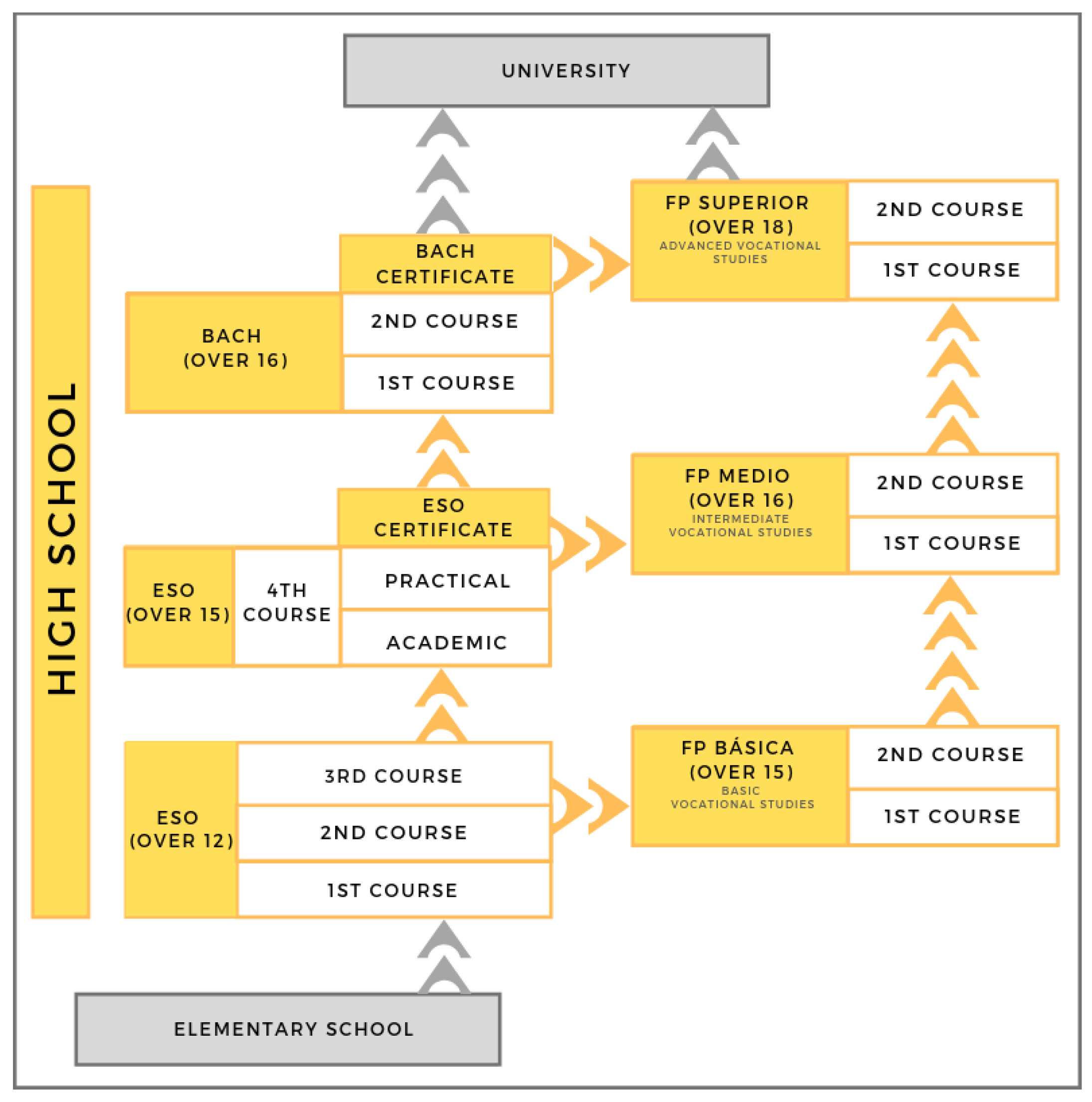
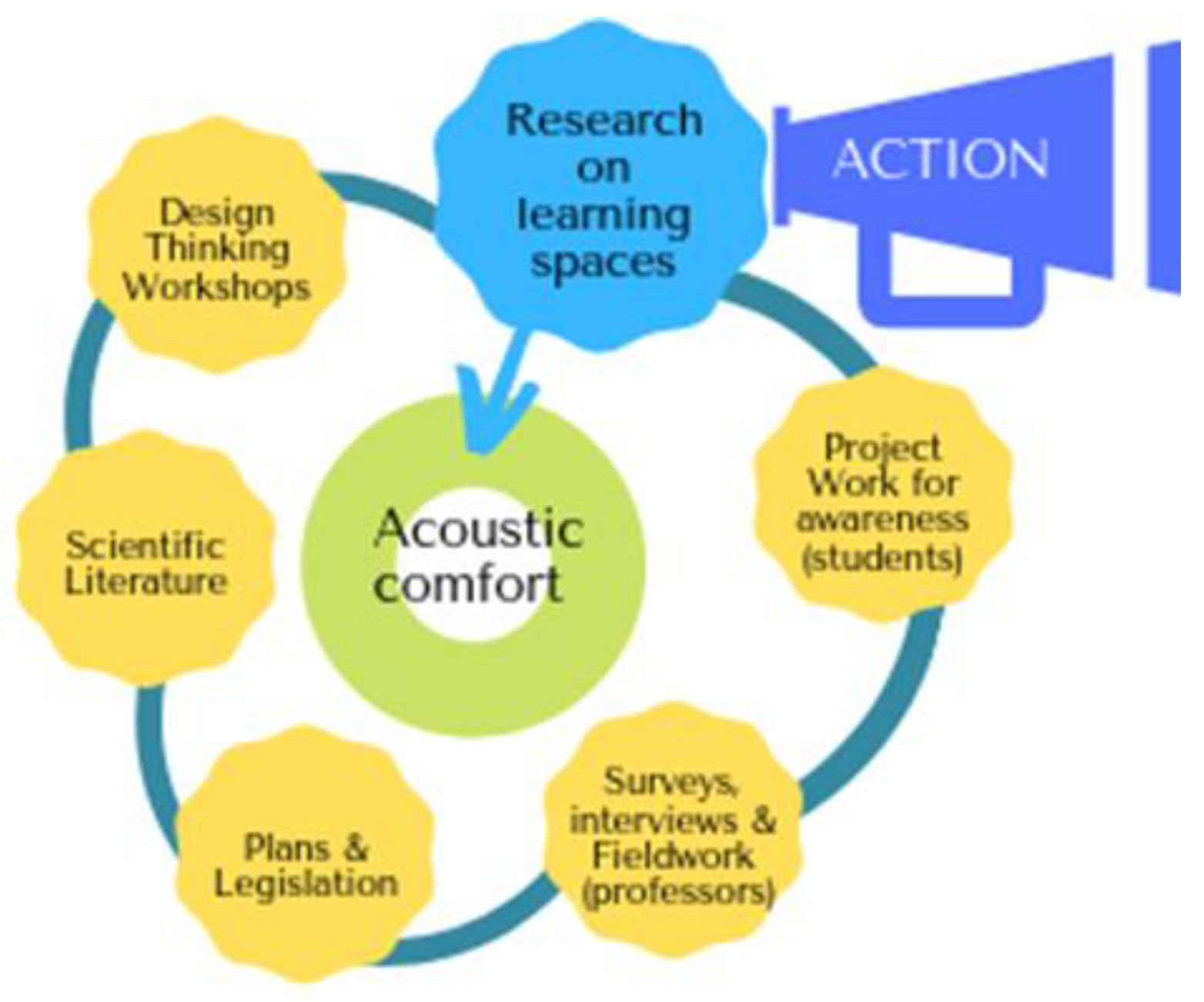
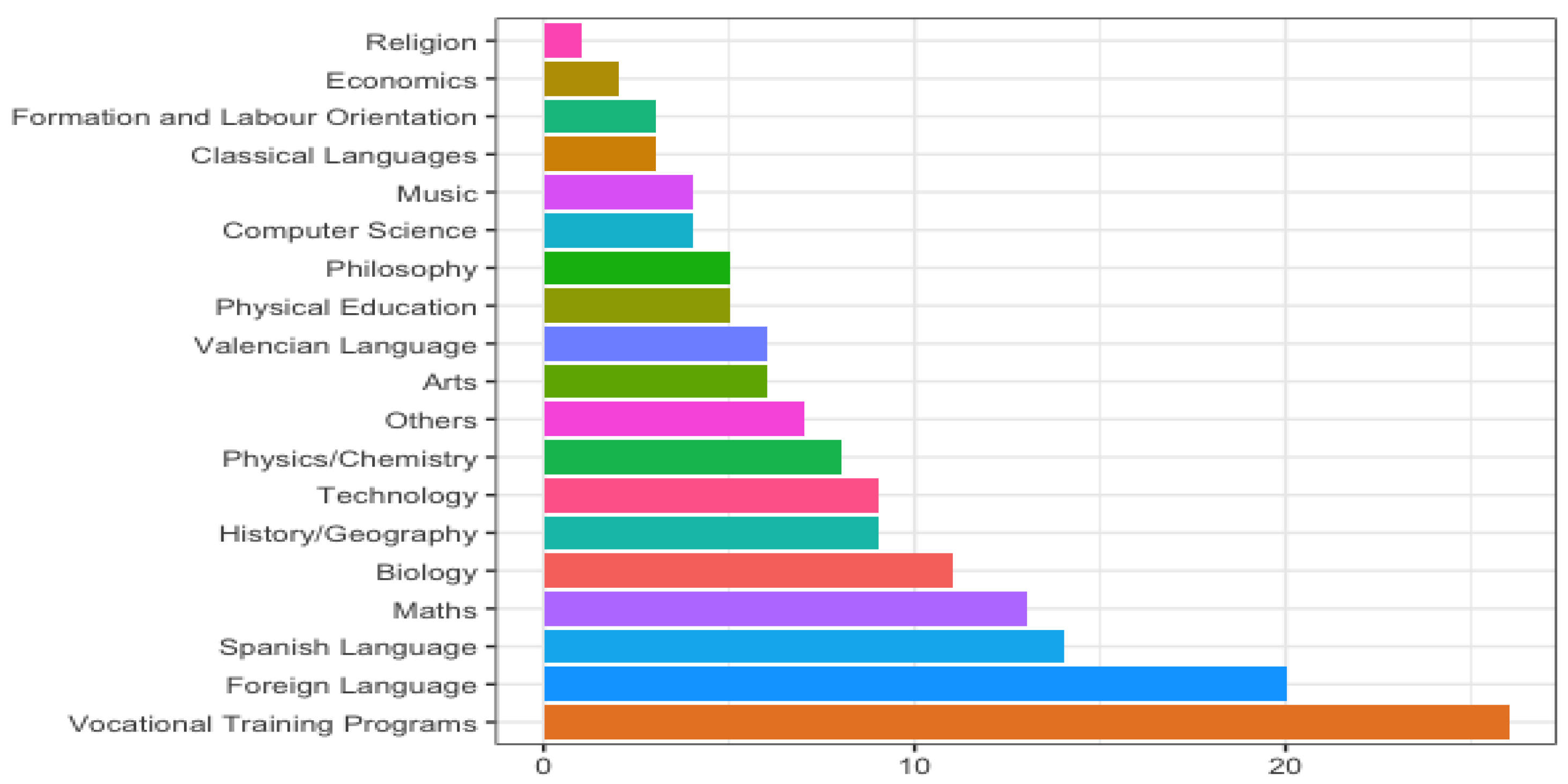
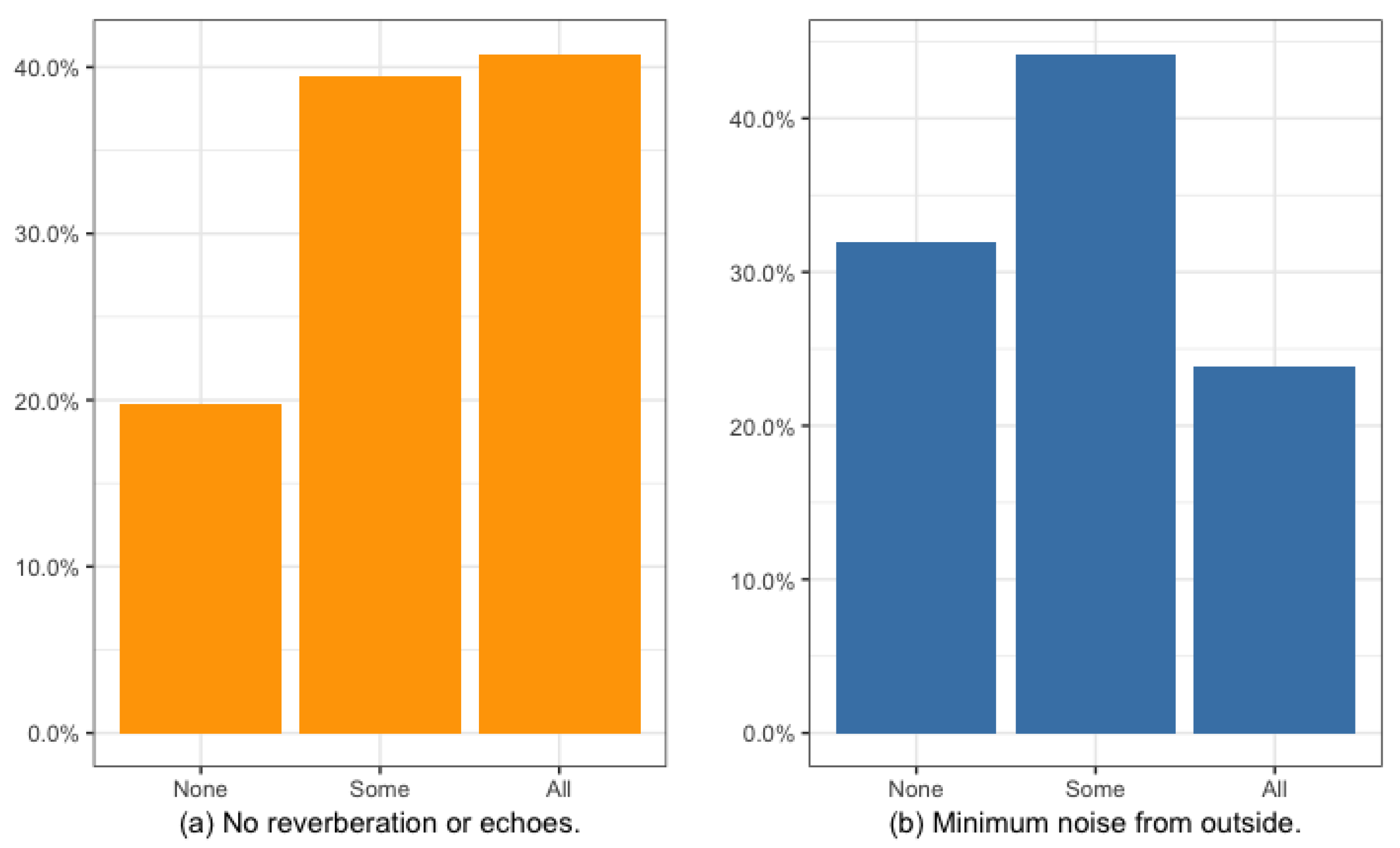
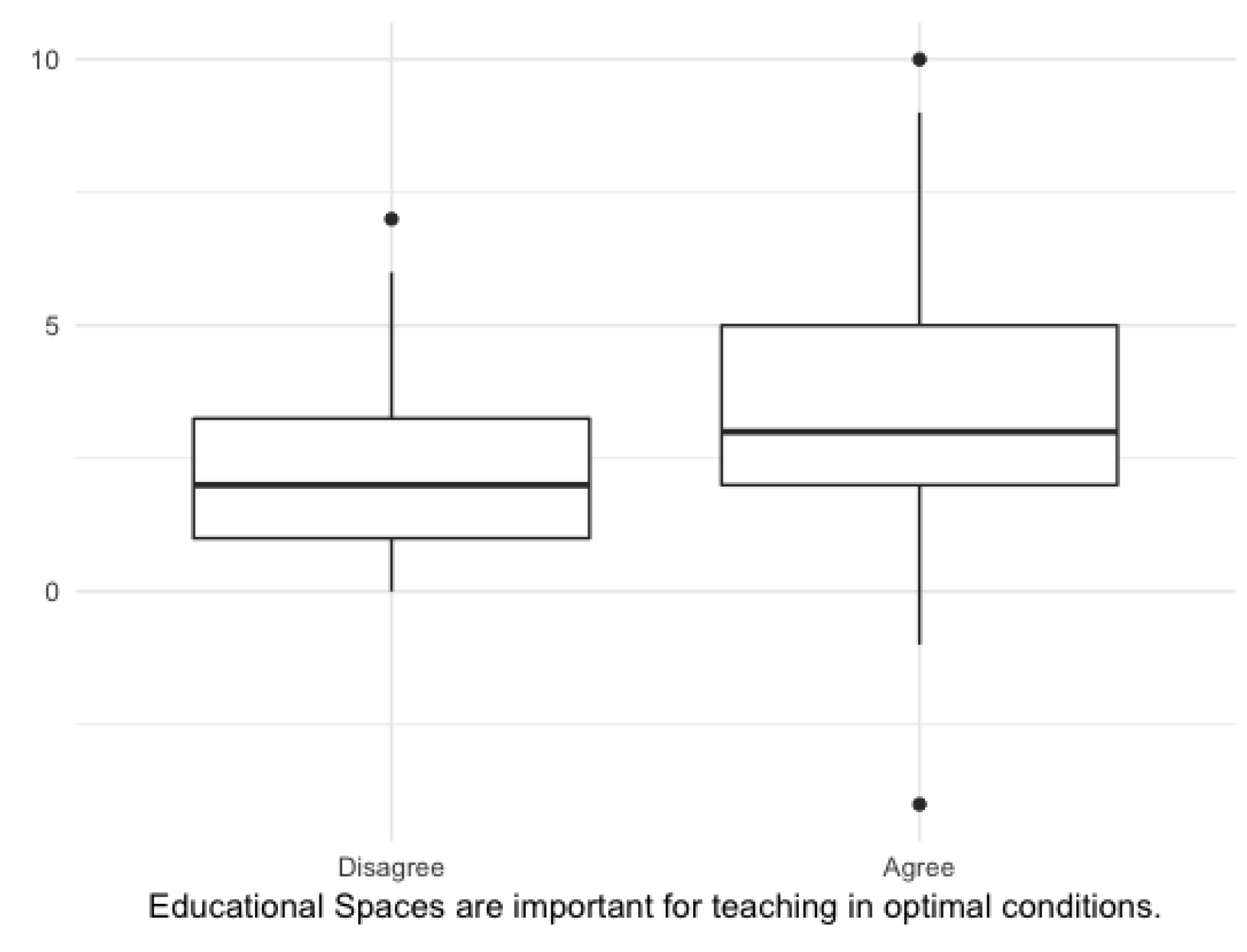
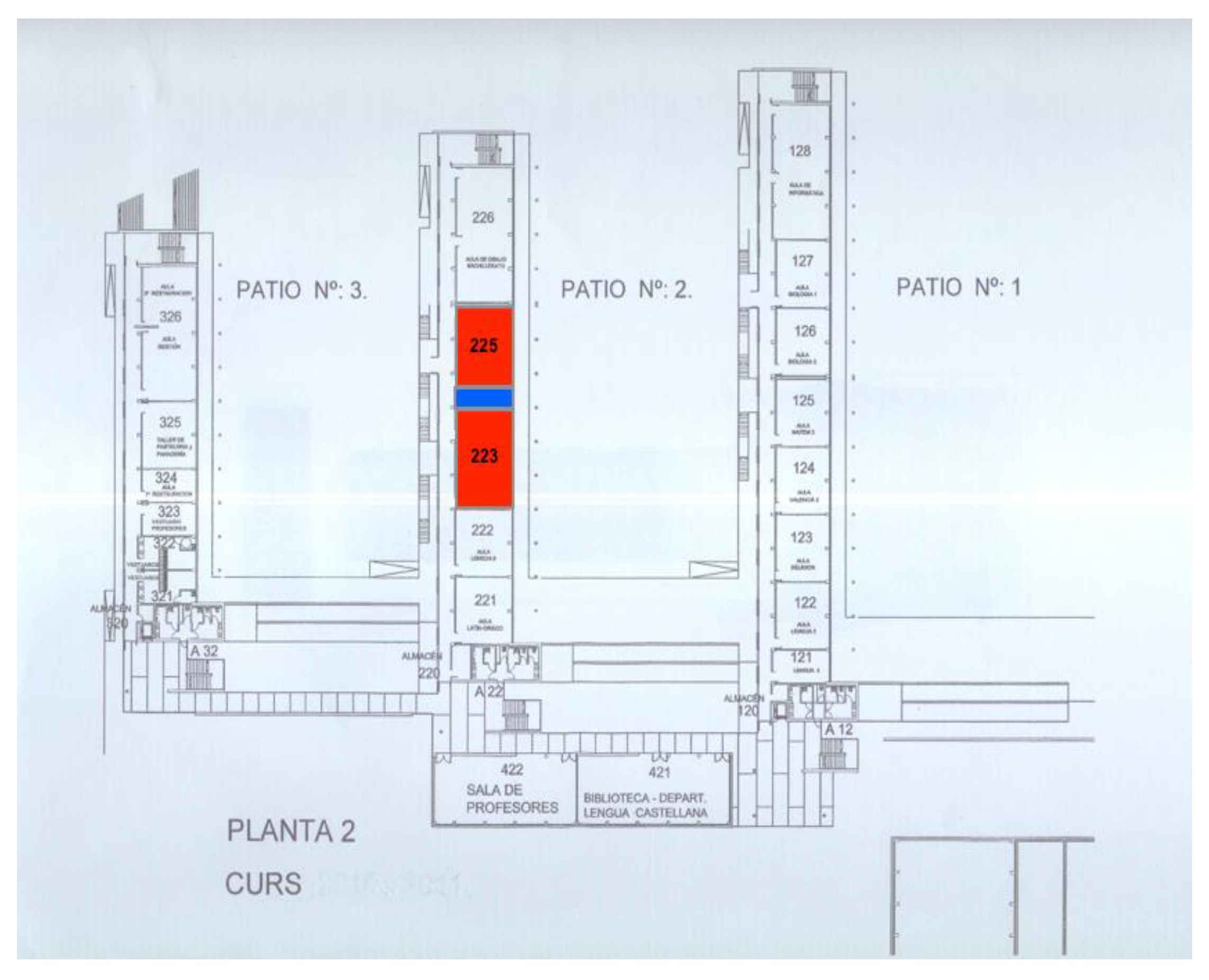
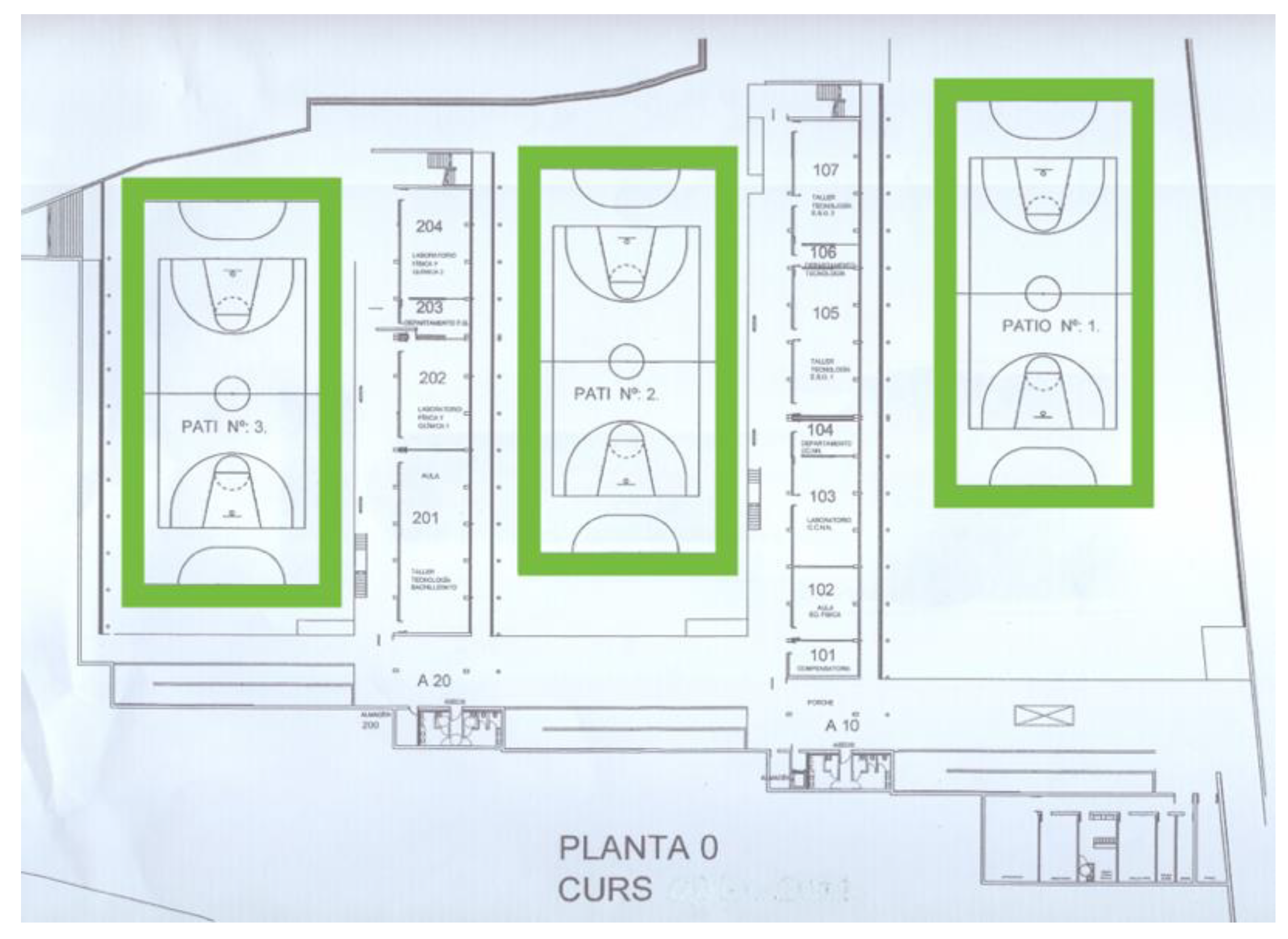

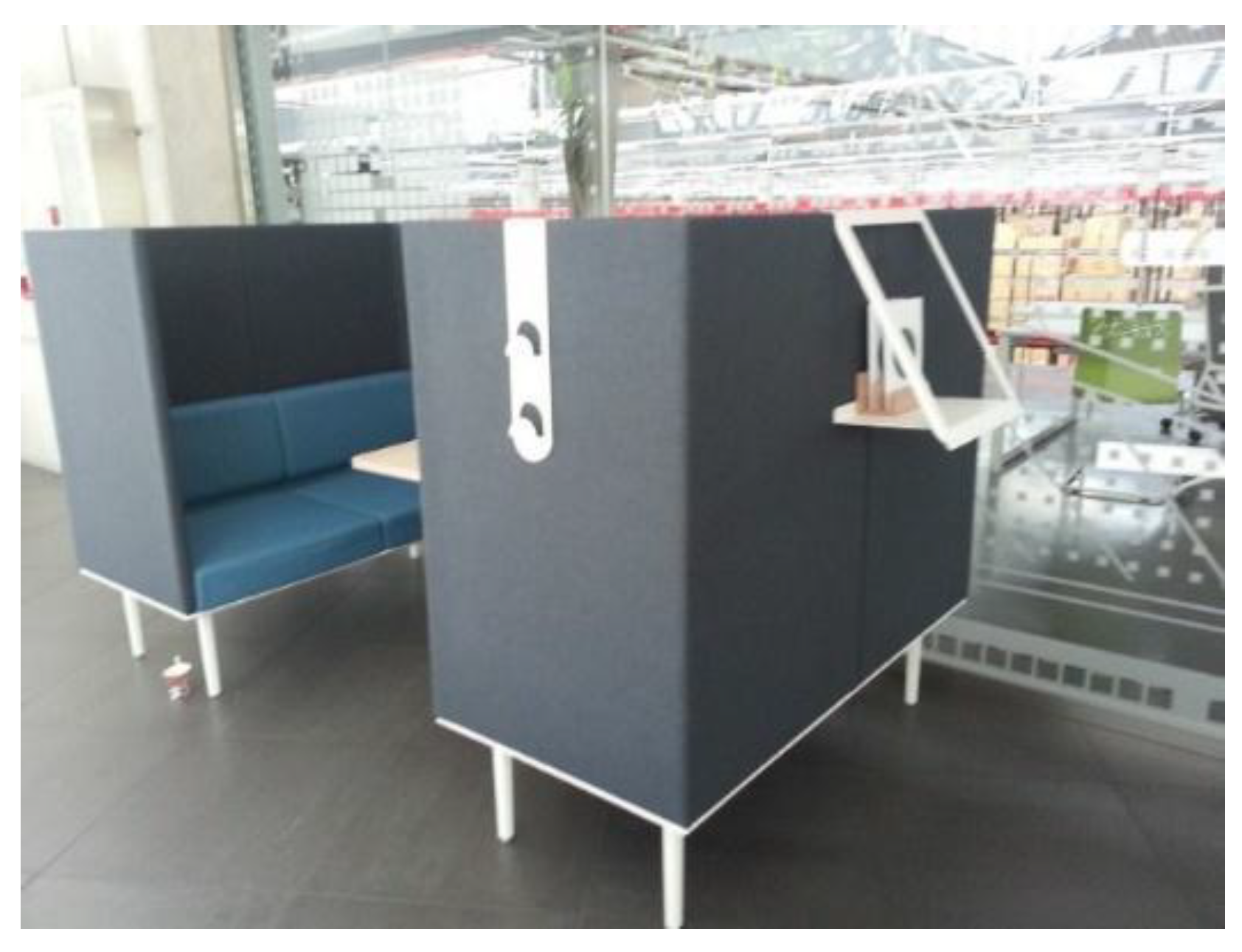
| Use of the Building | Type | Noise Level (L) | ||
|---|---|---|---|---|
| L Day | L Afternoon | L Night | ||
| Residential use | Living areas | 45 | 45 | 35 |
| Bedrooms | 40 | 40 | 30 | |
| Hospitals | Siting areas | 45 | 45 | 35 |
| Bedrooms | 40 | 40 | 30 | |
| Schools and cultural | Classrooms | 40 | 40 | 40 |
| Reading rooms | 35 | 35 | 35 | |
| COMPARATIVE TABLE OF DECIBELLS | |
|---|---|
| Birds singing | 20 dBA |
| Rustling of the wind in trees | 25 dBA |
| Reading room | 35 dBA |
| Computer | 45 dBA |
| Conversation between two people | 55 dBA |
| Vacuum cleaner | 70 dBA |
| Office (10 people) | 75 dBA |
| Garbage truck | 85 dBA |
| Road traffic | 90 dBA |
| Car horn | 95 dBA |
| Bus horn | 100 dBA |
| Disco music | 110 dBA |
| Motorcycles | 115 dBA |
| Hydraulic drill | 120 dBA |
| Jet airplane takeoff | 140 dBA |
© 2019 by the authors. Licensee MDPI, Basel, Switzerland. This article is an open access article distributed under the terms and conditions of the Creative Commons Attribution (CC BY) license (http://creativecommons.org/licenses/by/4.0/).
Share and Cite
Montiel, I.; Mayoral, A.M.; Navarro Pedreño, J.; Maiques, S. Acoustic Comfort in Learning Spaces: Moving Towards Sustainable Development Goals. Sustainability 2019, 11, 3573. https://doi.org/10.3390/su11133573
Montiel I, Mayoral AM, Navarro Pedreño J, Maiques S. Acoustic Comfort in Learning Spaces: Moving Towards Sustainable Development Goals. Sustainability. 2019; 11(13):3573. https://doi.org/10.3390/su11133573
Chicago/Turabian StyleMontiel, Isabel, Asunción M. Mayoral, Jose Navarro Pedreño, and Silvia Maiques. 2019. "Acoustic Comfort in Learning Spaces: Moving Towards Sustainable Development Goals" Sustainability 11, no. 13: 3573. https://doi.org/10.3390/su11133573
APA StyleMontiel, I., Mayoral, A. M., Navarro Pedreño, J., & Maiques, S. (2019). Acoustic Comfort in Learning Spaces: Moving Towards Sustainable Development Goals. Sustainability, 11(13), 3573. https://doi.org/10.3390/su11133573






